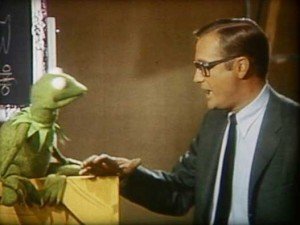Sesame Street Pitch Reel
But, besides providing some bite to the humor, Kermit also serves the function of representing the hypothetical dissenting voice to list any concern a TV exec or educator might have about the show, with Rowlf and later, Gerry Lesser, chairman of the CTW board from 1969 till 1996, refuting it through clips of already-completed short films and footage of the behind-the-scenes process, including footage of CTW meetings (with lots of smokers there, as well!), animation production, and even clips of the films being tested on children.
And these films are really nifty, particulary for someone who’s been watching Jim’s earlier short films because they actually have a great deal in common with his earlier, artsy work, however here they serve a more specific function of introducing various concepts to children. And yet, they share a very similar, stream-of-consciousness style. In one, simply called Round, Jim presents a series of round objects, many of which inner-city children would see in their day-to-day lives in their urban environment, such as car wheels, traffic lights, and manhole covers, each one fading into the other much like the juxtaposed images in his earlier films, and many times coming up with round shapes one might not even generally think of, such as a circular Coke ad, an orange slice, ball ornaments hanging on a Christmas tree, a rotary phone wheel, and finally a bubble gum bubble, which the child pops, the film then instantly rewinding to magically deflate and inflate it once more.
The arguably most famous of the bunch is Body Parts vs. Heavy Machinery, which plays with what otherwise would seem to be an abstract idea of the human body itself being a sort of machine, just like the ones humans build to do their heavy lifting. And so we see three little boys, one of whom is Brian Henson, playing in a sandbox, lifting sand with their hands and dumping it elsewhere in the box. Footage of the boys is then paralleled with images of large dump trucks doing similar things with dirt.
After a short while, this cleverly fades into a scene of the same three boys eating chocolate ice cream, similarly scooping and depositing it, only this time into their mouths. At one point, one of the other boys pretends to be “broken down,” so Brian boops his nose and turns an invisible crank to start him up again. What’s great about the film is that it’s playful and fun, and teaches these connections without ever putting too fine a point on it. The film never announces the lesson a child viewer should be getting from this, rather just presenting the connections and trusting that they’ll pick up on them, even if only subconsciously.
It’s also important to note that one of the two other little boys that Brian is playing with is African-American, which demonstrates the show’s idealistic commitment to normalize understanding and interaction between people from different ethnicities. When Sesame Street began, civil rights had only fully been effect for about a year, and so showing white and black boys playing together, with no differences in their behavior despite their different skin tones, was a powerful statement, all the more so because of how casually and naturally it’s portrayed. It isn’t an issue. It just is. And by making it a non-issue, it hoped to raise/foster a generation of unracist children.
A later cartoon introducing the letter “J” similarly pairs a white and black boy as best friends. That one’s also particularly fun due to the often crazily unexpected “J” words that appear, some of which would seem to be above most children’s perception, such as “junebug,” “judge,” and “Justice,” but which Sesame Street trusts them to be able to handle, whether or not they understand them all right away. This cartoon is also rather adorably of its time, ending on the very 1960s slang moral, “Don’t jive a judge by jamming a junebug”.
The pitch reel ends on Rowlf despairing over the show’s continued lack of name, and Kermit–cynical, exasperating Kermit–thinking about it for a moment and then just coming up with Sesame Street in seconds, sending Rowlf into a fit of ecstasy. Kermit doing this so naturally also feels fitting as he would come to be one of the show’s early stars, whereas Rowlf’s only appearance on the show itself would be–in Oscar’s words from The Great Muppet Caper–a “very brief cameo” in Season 1.
And, interestingly, Kermit’s role in Sesame Street would help skyrocket him to fame–particularly thanks to Joe Raposo, the show’s composer’s, brilliant, character-defining song, “Bein’ Green”–and finally eclipse Rowlf as the world’s most famous and loved Muppet. How was Rowlf to know that by convincing a reluctant Kermit to take part in Sesame Street, he would be ultimately sacrificing his own position as head honcho?!
And on Monday, I’ll be taking a look at The Cube, a bizarre, surrealistic, absurdist, possibly-sci-fi hour-long one-off drama Jim made for NBC that would be arguably his last fully avant-garde piece for many years, until The Dark Crystal in 1982.



